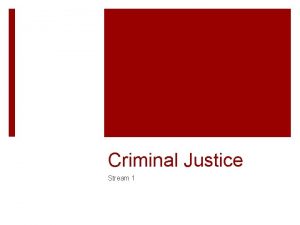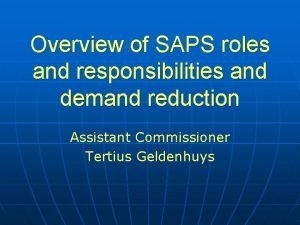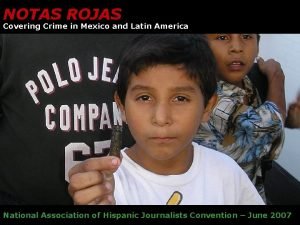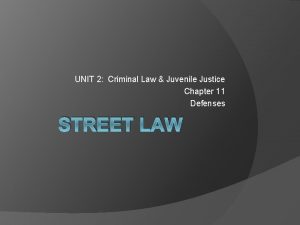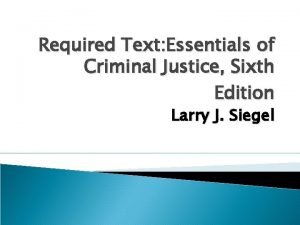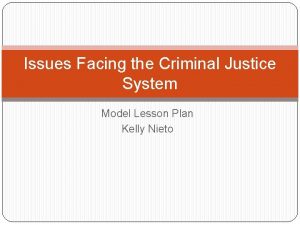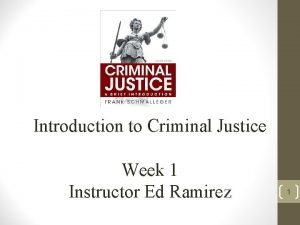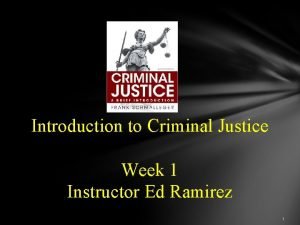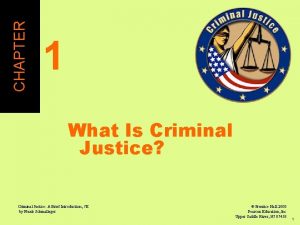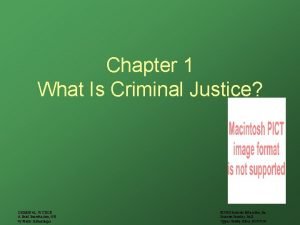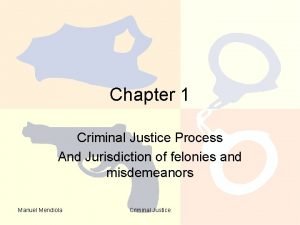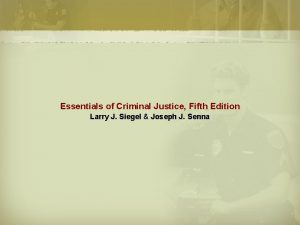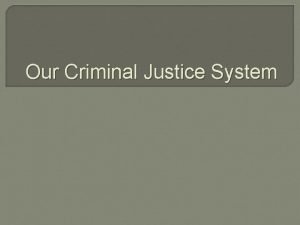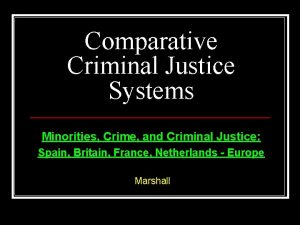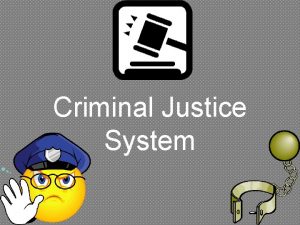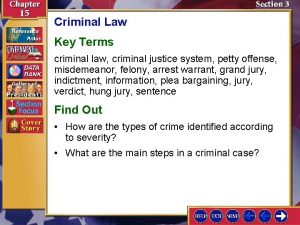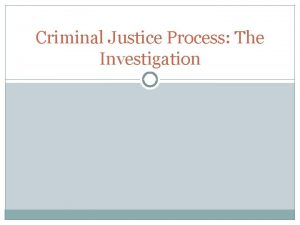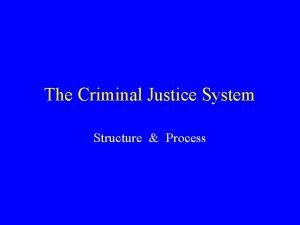Minorities and the Criminal Justice System Cross Cultural

























- Slides: 25

Minorities and the Criminal Justice System Cross Cultural Communication Copyright 2005 - 2009: Hi Tech Criminal Justice, Raymond E. Foster

What is Culture n “Beliefs, values, patterns of thinking, behavior and everyday customs that have been passed on from generation to generation” (Shusta, p. 19) n Or a group or community with which we share common experiences that shape the way we understand the world. Copyright 2005 - 2009: Hi Tech Criminal Justice, Raymond E. Foster

What is Culture n It includes groups that we are born into, such as gender, race, or national origin. It also includes groups we join or become part of: n For example, we can acquire a new culture by moving to a new region, by a change in our economic status, or by becoming disabled. Copyright 2005 - 2009: Hi Tech Criminal Justice, Raymond E. Foster

Communication Process by which information is exchanged and understood by two or more people, usually with the intent to motivate or influence behavior n Means to share, not "to speak" or "to write" Copyright 2005 - 2009: Hi Tech Criminal n Justice, Raymond E. Foster

Communications Model Sender The Person who sends the message Copyright 2005 - 2009: Hi Tech Criminal Justice, Raymond E. Foster

Communications Model Sender Encode To select symbols with which to compose a message Copyright 2005 - 2009: Hi Tech Criminal Justice, Raymond E. Foster

Communications Model Sender Encode Channel The carrier or form of communication Copyright 2005 - 2009: Hi Tech Criminal Justice, Raymond E. Foster

Communications Model Sender Encode Channel Decode Decoding or translating the message sent is the task of the receiver! Copyright 2005 - 2009: Hi Tech Criminal Justice, Raymond E. Foster

Communications Model Sender Encode Channel Decode The Person who receives the message Copyright 2005 - 2009: Hi Tech Criminal Justice, Raymond E. Foster Receiver

Communications Model Sender Encode Transmit Decode Receiver Feedback A response by the receiver to the sender’s Copyright 2005 - 2009: Hi Tech Criminal communication Justice, Raymond E. Foster

But, Wait, there’s more! Feedback Sender A response by the receiver to the sender’s communication Encode Transmit Decode Copyright 2005 - 2009: Hi Tech Criminal Justice, Raymond E. Foster Receiver

And More Noise Sender Any barrier to communication Encode Transmit Decode Copyright 2005 - 2009: Hi Tech Criminal Justice, Raymond E. Foster Receiver

Culture and Communications n n Messages are constructed from culture, or “beliefs, values, patterns of thinking, behavior and everyday customs that have been passed on from generation to generation” (Shusta, P. 97) Both the sender and the receiver use their cultural perceptions of encode and decode messages. Copyright 2005 - 2009: Hi Tech Criminal Justice, Raymond E. Foster

A little more about perception n Perception = Process used to sort out the environment n Perceptual selectivity = objects/stimuli are screened in or out and then selected Certain stimuli catch our attention We tend to see what we want to see. Copyright 2005 - 2009: Hi Tech Criminal Justice, Raymond E. Foster

Perception and Communication n Cultural organization = Categorizing according to our Cultural frame of reference n Stereotyping is the most common form of perceptual organization n Words can mean different things to different people. Copyright 2005 - 2009: Hi Tech Criminal Justice, Raymond E. Foster

Nonverbal Communication n Defined as actions, behaviors and intonation rather than words n n n Facial expression Voice Mannerisms Posture Dress Sometimes more believable and forceful Copyright 2005 - 2009: Hi Tech Criminal Justice, Raymond E. Foster

What is Cross Cultural Communications? Copyright 2005 - 2009: Hi Tech Criminal Justice, Raymond E. Foster

High-context and Low-context Communication n The degree to which senders and receivers rely on factors other than explicit speech to convey their messages Copyright 2005 - 2009: Hi Tech Criminal Justice, Raymond E. Foster

Context n “all the factors which systematically determine the form, meaning, appropriateness or translation of linguistic expressions. One can distinguish between linguistic context (provided by the preceding utterances or text) and nonlinguistic context (including shared assumptions and information). ” (Arnold, D). Copyright 2005 - 2009: Hi Tech Criminal Justice, Raymond E. Foster

Understanding the Difference n Low-context communication: n n “My words speak for themselves, " Prefer to be less direct, relying on what is implied by the communication. n High-context communication n n Prefer indirect messages from others Verbal and nonverbal cues help me understand the meaning Copyright 2005 - 2009: Hi Tech Criminal Justice, Raymond E. Foster

Different Context – Different Meaning I’m sorry. n What did you say? n I’m fine. n Others? Copyright 2005 - 2009: Hi Tech Criminal Justice, Raymond E. Foster

Low Context communicating with High Context n n n “nonverbal messages and gestures may be as important as what is said; status and identity may be communicated nonverbally and require appropriate acknowledgement; face-saving and tact may be important, and need to be balanced with the desire to communicate fully and frankly; building a good relationship can contribute to effectiveness over time; and indirect routes and creative thinking are important alternatives to problem-solving when blocks are encountered. “ (Le. Barron, M. ) Copyright 2005 - 2009: Hi Tech Criminal Justice, Raymond E. Foster

High Context communicating with Low Context n n n “things can be taken at face value rather than as representative of layers of meaning; roles and functions may be decoupled from status and identity; efficiency and effectiveness may be served by a sustained focus on tasks; direct questions and observations are not necessarily meant to offend, but to clarify and advance shared goals; and indirect cues may not be enough to get the other's attention” (Le. Barron, M. ) Copyright 2005 - 2009: Hi Tech Criminal Justice, Raymond E. Foster

References n n n Arnold, D. , et al. , (1995) Machine translation: an introductory guide http: //www. essex. ac. uk/linguistics/clmt/MTbook/ HTML/book. html Shusta, R. , et al. , (2005), Multicultural Law Enforcement. Prentice Hall, Upper Saddle River, NJ Le. Barron, M. (2003) Communication tools for understanding cultural differences. http: //www. beyondintractability. org/m/communi cation_tools. jsp Copyright 2005 - 2009: Hi Tech Criminal Justice, Raymond E. Foster

Cross Cultural Communications For more information on Leadership visit www. pokerleadership. com Copyright 2005 - 2009: Hi Tech Criminal Justice, Raymond E. Foster
 Criminal justice stream
Criminal justice stream Arizona criminal justice information system
Arizona criminal justice information system Responsibilities and functions of saps
Responsibilities and functions of saps Criminal justice wedding cake
Criminal justice wedding cake The american system of criminal justice 16th edition
The american system of criminal justice 16th edition Notas rojas
Notas rojas Criminal justice and public policy guelph
Criminal justice and public policy guelph Criminal justice and corrections
Criminal justice and corrections Unit 2 criminal law and juvenile justice
Unit 2 criminal law and juvenile justice Connecticut division of criminal justice
Connecticut division of criminal justice Essentials of criminal justice
Essentials of criminal justice Grass eater police
Grass eater police Eighth amendment excessive bail
Eighth amendment excessive bail Consensus model criminal justice
Consensus model criminal justice Consensus model criminal justice
Consensus model criminal justice Consensus model criminal justice
Consensus model criminal justice Typologies of crime
Typologies of crime Individual rights
Individual rights Consensus model criminal justice
Consensus model criminal justice Consensus model criminal justice
Consensus model criminal justice Nonintervention perspective of criminal justice
Nonintervention perspective of criminal justice Criminal justice wedding cake layers
Criminal justice wedding cake layers Department of criminal justice services ny
Department of criminal justice services ny National archive of criminal justice data
National archive of criminal justice data Criminal justice wedding cake diagram
Criminal justice wedding cake diagram Criminal justice
Criminal justice
